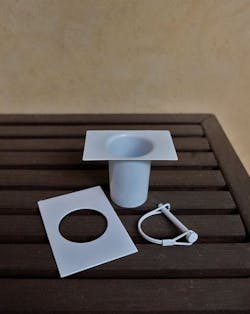Used in Japan for hundreds of years, rain chains have recently become more popular in Western countries as a decorative and functional alternative to traditional downspouts for diverting water from rooftops.
Not only are they an aesthetically unique addition to a home or garden, but they can also efficiently manage the flow of rainwater. According to Tancey Cullum Belken, Clemson University’s Water Resources Extension Agent and Forestry and Wildlife Agent, rain chains rely on simple physics to properly dispose of excess water and prevent flooding. Though, their performance compared with the traditional downspout is still up for debate.
The Science Behind Rain Chains
Rain chains are a simple yet effective method of managing rainwater runoff. They operate on the principle of surface tension, allowing the water to flow down the length of the chain, forming cascades of water.
“As rainwater collects in the gutters and begins to drain, it naturally follows the path of least resistance and follows the chain down to the ground,” says Belken. “During this process, water is slowed down, reducing associated energy and thus reducing soil loss and erosion.”
The rain chain on this house flows into a water basin.
Image: SEO Inc.
Installation Process
The installation process of a rain chain is relatively simple and can be accomplished in just a few steps. Once the downspout is removed, a gutter adaptor is installed, which is used to attach the rain chain to the gutter. The chain can then be hung above an anchoring dish or a rain barrel.
Selecting the proper rain chain depends on the home’s climate, says Belken. “Rain chains made of aluminum are lightweight and can be used in protected areas with little wind. Galvanized steel is a heavier rain chain; the associated durability makes for a good selection in areas of high winds,” she adds.
Rain chains help to direct water to rain barrels, landscaped beds, or other water features, but as with traditional downspouts, it’s important to make sure the water flowing from the chain is flowing away from the foundation of the home. When installed properly, rain chains can be used to redirect rainfall to parts of the yard where landscaping can absorb excess water.
A gutter adapter is needed to attach the rain chain to gutter.
Image: rainchains.com
Performance Compared to Downspouts
When it comes to performance, rain chains have some advantages over traditional downspouts. Firstly, they are an environmentally friendly option for managing rainwater runoff. As water flows down the chain, Belken says, it is distributed evenly, allowing it to infiltrate into the ground more efficiently. This helps to replenish the groundwater supply, and encourages plant growth near the runoff point.
In addition, rain chains are less expensive to install, and unlike standard downspouts, they don’t clog as they move water from the roof to the ground. They require little to no maintenance, but in the winter, ice can form along the chains and in the runoff cups, weighing down eaves or gutters.
In areas prone to heavy rainfall, downspouts may be the better option due to their higher capacity. Also, unlike rain chains, which direct water runoff on a vertical axis to the ground, downspouts push rain outwards, better protecting a home’s foundation.


